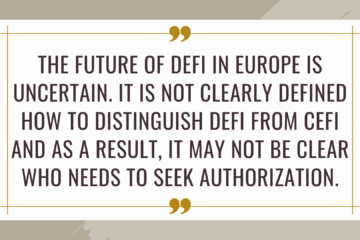Future EU Crypto Regulation MiCa
Here is a short (comparing to the original 200+ pages) summary of the future EU Regulation on how EU-wide crypto licenses and issuance of crypto assets may look like.
Key EU policy priorities:
- Expressed clear preference for harmonizing local counties domestic crypto licensing regimes to make them unified and passportable;
- Confirmed growing role of stablecoins and the fact that they have different nature (securities, e-money, hybrids, algorithmic stabilizers of price, etc) and expressed a preference to regulate stablecoins as a separate class of assets, unless those stablecoins clearly meet the definition of e-money or security, in which case, they should be regulated by those respective directives;
- Introduced a category of “significant e-money tokens” (presumably with Libra in mind) that should be subject to even more stringent oversight due to systemic impact;
- Emphasized the role of custody for crypto assets and made it mandatory to segregate clients’ crypto funds with a bank or a regulated VASP.
Key definitions:
Asset-referenced tokens – crypto-assets whose main purpose is to be used as a means of exchange and that purports to maintain a stable value by referring to the value of several fiat currencies, one or several commodities or one or several crypto-assets, or a combination of such assets;
E-money tokens – crypto-assets whose main purpose is to be used as a means of exchange and that purports to maintain a stable value by being denominated in (units of) a fiat currency.
Significant electronic money or asset-based tokens (aka Libra & Co.) – are tokens that have been classified as significant in accordance with the following criteria:
- customer base over 2 million of natural or legal persons;
- the market capitalization equal or over EUR 2 billion;
- daily transactions in equal or over 1 million transactions per day or their volume is equal or over EUR 1 billion per day respectively;
- average clients’ funds’ value (or value of assets locked) is equal or over EUR 2 billion;
- a token is used in cross-border payments in more than 7 EEA countries
Utility tokens – crypto-assets which are intended to provide access digitally to an application, services, or resources available on a distributed ledger and that are accepted only by the issuer of that token to grant access to such application, services, or resources available.
Future service categories that will require license application in the EEA:
(a) Custody and administration of crypto-assets on behalf of third parties (the custody and administration of crypto-assets on behalf of third parties’ means safekeeping or controlling, on behalf of third parties, crypto-assets or the means of access to such crypto-assets, where applicable in the form of private cryptographic keys);
(b) Operation of a trading platform for crypto-assets (managing one or more crypto-assets trading platforms, within which multiple third-party buying and selling interests for crypto-assets can interact in a manner that results in a contract, either by exchanging one crypto-asset for another or a crypto-asset for a currency that is legal tender);
(c) Exchange of crypto-assets for fiat currency (concluding purchase or sale contracts concerning crypto-assets with third parties against a currency that is legal tender, by using proprietary capital);
(d) Exchange of crypto-assets for other crypto-assets (concluding purchase or sale contracts concerning crypto-assets with third parties against other crypto-assets, by using proprietary capital);
(e) Execution of orders for crypto-assets on behalf of third parties (concluding agreements to buy, sell or subscribe for one or more crypto-assets on behalf of third parties);
(f) Placement of crypto-assets (the marketing of newly-issued crypto-assets or of crypto-assets that are already issued, but not admitted to trading on a trading platform for crypto-assets, to specified purchasers and which does not involve an offering to the public or an offering to existing holders of the issuer’s crypto-assets);
(g) Reception and transmission of orders for crypto-assets on behalf of third parties (the reception and transmission of orders for crypto-assets on behalf of third parties means the reception from a person of an order to buy, sell or subscribe for crypto-assets and the transmission of that order to a third party for execution);
(h) Advice on crypto-assets (offering, giving, or agreeing to give personalized or specific recommendations to a third party either at the third party’s request or on the initiative of the crypto-asset service provider providing the advice, concerning the acquisition or the sale of one or more crypto-assets, or the use of crypto-asset services);
(i) Execution of payment transactions in asset-referenced tokens (the activity, conducted on behalf of one or several natural or legal persons, of transferring an asset-referenced token from one address or registered position used to receive crypto-assets to another, irrespective of any underlying obligations between the sender and the recipient).
How crypto-assets can be issued in the future?
An issuer can offer a crypto-asset (other than securities, e-money, or other asset-referenced tokens) when they
- have proper governance and security measures in place
- publish the Whitepaper (and any significant changes thereto)
- notify their home regulator (and any significant changes thereto)
This requirement does not apply if tokens:
- are issued for free (however, if the issuer is rewarded by receiving data or personal data from the prospective holders or where the issuer receives any fees, commissions, monetary benefits, or non-monetary benefits from the prospective holders of crypto-assets or any third party)
- are automatically created (e.g. for mining or transaction validation),
- are non-fungible,
- are offered to less than 150 people in each of the EEA member countries,
- total consideration received for the tokens issued is under 1 million EUR over 12 months equivalent in another currency or in crypto-assets, over a period of 12 months;
- are only offered to the qualified investors (and can only be later on sold to qualified investors)
During the token issuance, the issuer can receive funds from the buyers only via engaging either a bank or an authorized crypto custodian.
Issuance of asset-referenced tokens:
The issuer of the asset-referenced tokens must be an authorized and regulated institution, must publish the whitepaper, and notify local regulator, unless:
- the asset-referenced tokens are marketed and distributed exclusively to qualified investors and can only be held by qualified investors; or
- if the average outstanding amount of asset-referenced tokens (including e-money) does not exceed EUR 5.000.000, or the corresponding equivalent in another currency, over a period of 12 months, calculated at the end of each calendar day.
Exceptions:
Requirements above with respect to the issuance of the asset-referenced tokens shall not apply to crypto-assets that:
(a) do not reference one or several fiat currencies, one or several commodities, or one or several crypto-assets, or a basket of such assets; and
(b) aims at maintaining a stable value, via protocols, that provide for the increase or decrease of the supply of such crypto-assets in response to changes in demand (e.g. algorithmic stablecoins).
In that case, the issuer of such crypto-assets shall produce a whitepaper and notify their local regulator.
Capital requirements
The higher of either EUR 350,000; or 2% of the average amount of the reserve assets (e.g. float or value of assets locked) and 3% for issuers of significant asset-referenced tokens.
Can you invest clients’ funds or assets locked?
- Yes, it is possible to invest clients’ funds and reserves but only in highly liquid financial instruments with minimal market and credit risk. The issuer’s investments shall be capable of being liquidated rapidly with minimal adverse price effect.
- All profits or losses, including fluctuations in the value of financial instruments, counterparty, or operational risks, resulting from the investment of the reserve assets shall be borne by the issuer of the asset-referenced tokens.
- Issuers of asset-referenced tokens or e-money tokens cannot grant interests or any other benefit related to the length of time during which a holder of asset-referenced tokens holds such crypto-assets.
Authorization timing and deadlines
- Local regulators must within 20 working days of receipt of the license assess whether that application is complete. Where the application is not complete, the authority shall set a deadline by which the prospective issuer of asset-referenced tokens is to provide the missing information. Within that assessment period of 20 working days, the competent authority may also indicate that the draft whitepaper is incomplete or that additional information shall be included in the draft whitepaper.
- Where an is complete, the competent authority shall immediately notify the prospective issuer of asset-referenced tokens thereof.
- Regulators must within three months from the receipt of a complete application, assess whether the prospective issuer of asset-referenced tokens complies with the requirements and shall take a fully reasoned draft decision granting or refusing authorization.
How to issue tokenized E-money:
- You must have an EMI or banking license.
- Token holders must be granted the right of a claim on the issuer of such e-money tokens. Any e-money token that does not provide all holders with a claim shall be prohibited.
- E-money must be denominated in fiat and issued at par value and on the receipt of (fiat) funds.
- E-money tokens must be redeemable at the request of the holder at any moment and at par value either in cash or by credit transfer.
- The issuer of e-money tokens must prominently state the conditions of redemption, including any fees relating thereto, in the whitepaper. Redemption may be subject to a fee-only if stated in the whitepaper.
- Safeguarding of funds received in exchange for issued e-money tokens must be ensured.
Crypto custody of clients’ funds and payments services with crypto funds
- Where their business models or the crypto-asset services require holding funds belonging to clients, crypto-asset service providers shall always segregate and safeguard clients’ funds and prevent the use of clients’ funds for their own accounts.
- Safeguarding can be done either with an authorized bank, credit institution, or authorized crypto custodian.
- Crypto-asset service providers may themselves, or through a third party provide payment services related to the crypto-asset service they offer, provided that the crypto-asset service provider itself, or the third-party, is a payment institution or an EMI under PSD2.


